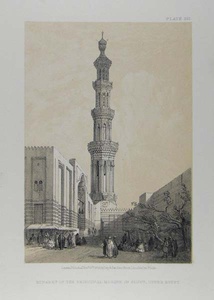| Method | Lithograph with tint stone |
| Artist | after David Roberts |
| Published | London, Published Novr. 15th. 1856 by Day & Son, Gate Street, Lincoln's Inn Fields |
| Dimensions | Image 208 x 138 mm, Sheet 285 x 195 mm |
| Notes |
Plate 231 from Volume 6 of the small format reprint of Roberts' The Holy Land, Syria, Idumea, Arabia, Egypt & Nubia. A view of the minaret of the mosque of Asyut, Egypt. Asyut is an ancient city, tracing its foundations from at least 3,100 BC when it was the capital of Upper Egypt's thirteenth nome. The city's cult temple to Anubis gained it the name of Lycopolis ('Wolf-city') in Greek sources. Historically, the city was important for its connection with Coptic Christianity, and in the modern era it is still home to the highest concentration of Coptic Christians in Egypt. In Roberts' view, the minaret and wall of the city's mosque are depicted on the corner of a street that runs parallel with the city wall. A small encampment of men have set up under a tree near the wall, while others gather around a tented stall on the opposite side of the street. David Roberts RA (24th October 1796 – 25th November 1864) was a Scottish painter. He is especially known for a prolific series of detailed prints of Egypt and the Near East produced during the 1840s from sketches made during long tours of the region (1838-1840). This work, and his large oil paintings of similar subjects, made him a prominent Orientalist painter. He was elected as a Royal Academician in 1841. The firm of Day & Haghe was one of the most prominent lithographic companies of the nineteenth-century. They were also amongst the foremost pioneers in the evolution of chromolithography. The firm was established in 1823 by William Day, but did not trade under the moniker of Day & Haghe until the arrival of Louis Haghe in 1831. In 1838, Day & Haghe were appointed as Lithographers to the Queen. However, and perhaps owing to the fact that there was never a formal partnership between the two, Haghe left the firm in the 1850's to devote himself to watercolour painting. The firm continued as Day & Son under the guidance of William Day the younger (1823 - 1906) but, as a result of a scandal involving Lajos Kossuth, was forced into liquidation in 1867. Vincent Brookes bought the company in the same year, and would produce the caricatures for Gibson Bowles' Vanity Fair magazine, as well as the illustrations for Cassells's Poultry Book, amongst other commissions. Condition: Slight foxing to margins, not affecting image. |
| Framing | unmounted |
| Price | £30.00 |
| Stock ID | 39058 |

